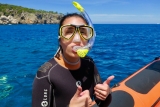The good thing about adventure sports is that they reveal unique possibilities for getting to know animal and plant species. If you can, it is highly recommended that you take a diving trip, as you will reach places like the Mediterranean Sea where you will find animals like the seal. monk, scientifically called Monachus monachus.

Distribution area
The original distribution area of this marine mammal covered all the coastal waters of the Mediterranean Sea and its Atlantic surroundings: the Canary Islands, Madeira, Western Sahara and Mauritania. However, currently, its population is greatly reduced and it survives in specific places in its former distribution area. Although it is not known exactly, currently the world population is estimated between 400 and 500 specimens distributed mainly in three geographical areas: the eastern Mediterranean (in the Greek and Turkish islands, with about 200 specimens); the western Mediterranean (Algeria and Morocco, with an estimated maximum between 20 and 50 individuals), and the western Sahara (about 200 individuals).
Until a few decades ago, the monk seal was still present on all Spanish coasts. Once it was an abundant species that had colonies of several thousand specimens in places such as the island of Lobos, in Fuerteventura. The chronicles narrate that the sailors of the ships, before crossing the Atlantic towards the Americas, stopped there to hunt seals and with them to make a supply of oil and meat.
We have proof of the abundance of the monk seal in the past in the numerous place names that we find on the Spanish coast that refer to the species, which according to the regions has been known as: sea lion, llop marí, vellmarí, ca mari, etc. They could be enjoyed more often through cetacean watching.

What has happened to the monk seal population? What are the causes that have led to its imminent extinction?
For about thirty years the regression of the species has been announced. The chronicle of the monk seal is that of an announced extinction. Meanwhile, the population has been decreasing dramatically and has disappeared from the Spanish coasts due to the inability and indifference of our Administration and its technicians, that they have done nothing to prevent it.
There are several factors that have caused the regression of the species:
- Persecution by man
- Pollution of the Mediterranean
- Human pressure on the coasts
- Overfishing and resource depletion
Of all of them, direct persecution is without a doubt the main cause of the decline.
This wonderful animal was always considered by fishermen as a harmful beast that depleted fishing resources and destroyed fishing gear. Most of the information available about the species in this century refers to hunting actions for specimens.

Recovery work
Faced with such a bleak outlook, we consider the recovery measures and work and ask ourselves if the species has the possibility of recovering its past status or, at least, of preserving it. About twenty years ago, the first working groups were formed to study the biology of the species and take measures aimed at its protection and recovery.
Addressing in a report like this the possibilities of recovery of the monk seal, in a concrete and abbreviated way, is difficult due to the complexity. The main obstacle to establishing general measures aimed at the recovery of the species consists of the divergence of opinions between the different working groups. For years there has been talk of captive breeding, transfer of specimens to protected areas to establish new population groups, transfer of puppies to recovery centers, etc.

But to date hardly anything has been done, partly due to the lack of knowledge of the biology of this marine mammal and partly because of an insurmountable barrier: the low number of existing specimens. This makes it difficult to predict whether the remedy or the disease is worse: if specimens are extracted from one of the current groups, there are no guarantees that the donor population group will not be put at risk.
The terrible thing is that we find ourselves in a fight against the clock. While there is speculation about appropriate measures, populations are declining. About two years ago, about two hundred specimens died on the coasts of the Sahara due to a red tide. Although it is due to natural causes, this unfortunate mortality can be a death blow if this population does not manage to recover.
The present and future of our monk seal are that complicated when analyzed in terms of realistic way. The chances of recovery of the species are minimal. And if the extinction of the monk seal occurs, with it will go a little of ourselves, of our culture, an important part of our beloved and much abused Mediterranean.

It is inevitable to wonder if there is room in the Mediterranean for man and the monk seal. In the hypothetical case that its population recovered, would coexistence between man and monk seal be possible? To find the answer to this question, just look at other latitudes, such as, for example, the Californian coast. In this area, not only are seals and sea lions not persecuted, in addition, in the ports of these coasts we will see how man has placed platforms so that they can come out of the water to rest and relax.
We say goodbye to this wonderful animal, whose population we have massacred, dreaming of a future, perhaps impossible, in which monk seals will once again swim in the crystalline waters of the Mediterranean and lie on the sand of its beaches.
















